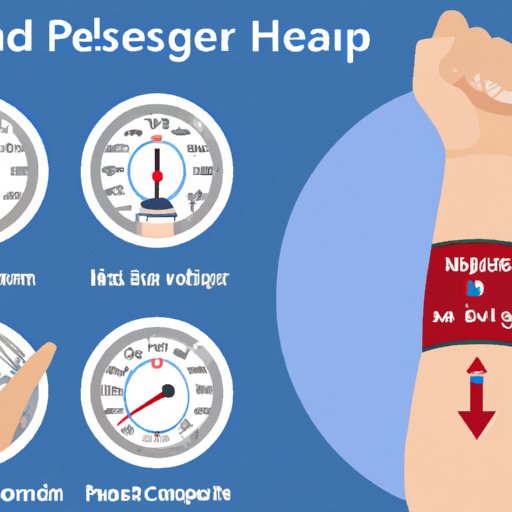
Introduction
High blood pressure, also known as hypertension, is a common condition that affects millions of people worldwide. It occurs when the force of your blood against the walls of your arteries is too high, leading to a variety of health problems over time. Identifying high blood pressure is crucial because it often has no noticeable symptoms until it has caused serious harm. In this article, we’ll explore how you can identify high blood pressure, its risks, and what you can do to manage it.
The Silent Killer: How to Identify High Blood Pressure and its Risks
High blood pressure is often referred to as “The Silent Killer” because it can silently damage your blood vessels and organs over time without any visible symptoms. However, there are some common symptoms that may indicate you have high blood pressure, such as headaches, dizziness, shortness of breath, and nosebleeds. If left untreated, high blood pressure can lead to several health complications, including heart disease, stroke, kidney disease, and vision loss.
5 Signs Your Blood Pressure is Too High: What You Need to Know
Here are five of the most common signs that your blood pressure is too high:
- Headaches: Headaches are a common symptom of high blood pressure. If you experience frequent headaches that are worse in the morning, it is important to get your blood pressure checked.
- Shortness of Breath: If you experience shortness of breath or difficulty breathing with exertion, it may be due to high blood pressure.
- Persistent Chest Pain: Chest pain is a symptom that is often associated with heart problems. High blood pressure can cause chest pain, especially during physical activity.
- Nosebleeds: Although nosebleeds are not necessarily a direct symptom of high blood pressure, they can be an indication that something is wrong with the blood vessels, which could be due to high blood pressure.
- Visual Changes: High blood pressure can cause damage to the tiny blood vessels in the eyes, which may lead to visual changes and even vision loss.
It’s important to note that many people with high blood pressure do not experience any symptoms at all. That’s why it’s essential to get your blood pressure checked regularly, even if you don’t have any symptoms.
A Beginner’s Guide to Understanding High Blood Pressure
Blood pressure is the force that blood exerts on the walls of your arteries as it flows through them. It is measured with two numbers: the systolic pressure (the top number), which represents the pressure when your heart beats and pumps blood through your arteries, and the diastolic pressure (the bottom number), which represents the pressure when your heart is at rest between beats.
The normal range for blood pressure is <120/<80 mmHg (millimeters of mercury), and high blood pressure is defined as >130/>80 mmHg. However, it is important to note that healthy blood pressure ranges can vary depending on age, gender, and other factors.
Checking Your Blood Pressure: Why It’s Important and How to Do It
Regular blood pressure checks can help you identify high blood pressure and take steps to manage it. It is recommended that adults get their blood pressure checked at least once a year, although more frequent checks may be necessary if you have certain risk factors.
There are two types of blood pressure monitors: manual and digital. Manual monitors use a stethoscope and an inflatable cuff that is wrapped around your arm to measure your blood pressure. Digital monitors use an electronic sensor and display your blood pressure reading on a screen. To get an accurate reading, it’s important to follow the instructions for whichever type of monitor you are using.
If you are checking your blood pressure at home, there are some tips you should keep in mind to ensure accurate readings. You should sit down and relax for 5 minutes before taking your blood pressure, and avoid smoking, drinking caffeine, or exercising for at least 30 minutes before the reading. You should also ensure that the cuff is the correct size for your arm, and take multiple readings at different times of the day to get a better overall picture of your blood pressure.
The Dangers of High Blood Pressure and How to Manage It
The dangers of high blood pressure are many, including an increased risk of heart attacks, strokes, kidney disease, and eye problems. However, there are several lifestyle changes you can make to help manage high blood pressure, including:
- Losing weight if you are overweight or obese
- Exercising regularly
- Eating a healthy diet that is low in salt, fat, and cholesterol
- Managing stress through meditation, yoga, or other relaxation techniques
- Avoiding smoking and excessive alcohol consumption
In addition to lifestyle changes, some people may need to take medication to manage their high blood pressure. There are different types of blood pressure medications, including diuretics, ACE inhibitors, and beta-blockers, and your doctor can help you determine which one is right for you.
Conclusion
Identifying and managing high blood pressure is critical for maintaining good health and preventing serious complications. Regular blood pressure checks, lifestyle changes, and medication when necessary can help you manage your blood pressure and reduce your risk of heart disease, stroke, and other health problems. If you have high blood pressure or are at risk for it, talk to your doctor about a personalized treatment plan that works for you.




